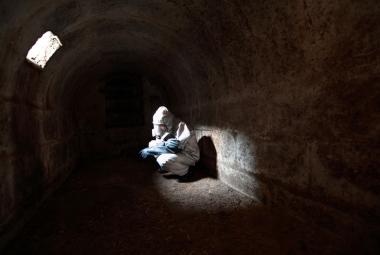The “Four Horsemen of the Apocalypse” have become the ultimate symbols of gloom and doom in literature and other entertainment projects. The fourth of these is certainly amongst the most terrifying:
And when he had opened the fourth seal, I heard the voice of the fourth beast say, Come and see.[1]
And I looked, and behold a pale horse: and his name that sat on him was Death, and Hell followed with him. And power was given unto them over the fourth part of the earth, to kill with sword, and with hunger, and with death, and with the beasts of the earth.
Commonly referred to as pale, or green, the manuscript term used here is actually χλωρός chloros: green, yellowish pale, or livid.[2] (gangrene?)
And furthermore, this one is accompanied by a duet (note the plural pronoun in v.8): one for the body and one for the soul.
Setting aside the theological distinctives between these two, we are also confronted with the dispatching of one person among every four on the Planet Earth!
Jesus warned us:
And except those days should be shortened, there should no flesh be saved: but for the elect’s sake those days shall be shortened.
From a number of supplemental references, we recognize that the “beasts of the earth” are not necessarily visible to the naked eye: they can include microbes, bacteria and viruses.[3]
The Threatening Medical Horizon: Re-emergent Diseases
There was a time when the medical profession felt they had the major diseases licked, and for the rest it was just a matter of time. Now their confidence appears tragically premature. Many of the old “once licked” diseases are making a comeback, in hardier strains than ever, and resisting our once effective treatments.
Tuberculosis: new highly resistant strains of TB are of increasing concern. This airborne germ has also been known to carry HIV, allowing it to “piggyback” and become contagious in the air.
Staphylococcus aureus: Staph bacteria is the number one cause of hospital infections. They are blamed for 13% of the nation’s 2 million hospital infections each year, which kill 60–80,000 people each year. A new strain of Staphylococcus aureus showed resistance for the first time against vancomycin, which has been around since 1970 and is used when other antibiotics fail. The increasing resistance is attributed to overuse of antibiotics and the failure of some patients to take their medicine properly. Some patients stop taking their medication once they feel better but before the infection has been knocked out, enabling the hardiest germs to survive and multiply.
Ebola: Ebola virus kills as many as 90% of its victims in little more than a week. Connective tissue liquefies, every orifice bleeds. In the final stages, Ebola victims become convulsive, splashing contaminated blood around them as they twitch, shaking and thrashing to their deaths. No specific treatment or vaccine for the virus is available, although a number of potential treatments are being studied. The disease was first identified in 1976 in two simultaneous outbreaks, one in Nzara, and the other in Yambuku, a village near the Ebola River from which the disease takes its name. Between 1976 and 2013, the World Health Organization reports a total of 24 outbreaks involving 1,716 cases. The largest outbreak is the ongoing epidemic in West Africa, still affecting Guinea and Sierra Leone. As of 9 May 2015 this outbreak has 26,683 reported cases resulting in 11,022 deaths.
Biological Weapons
If chemical attacks are frightening, a biological weapon poses an even worse nightmare. Chemical agents are inanimate, but bacteria, viruses and other live agents may be contagious and reproductive. If established in the environment, they may multiply. Unlike any other weapon, they can become more dangerous over time.
Bacillus anthracis: Rod-shaped, gram-positive, anaerobic, sporulating microorganism, the spores constituting the usual infective form. Causes anthrax. If bacteria are inhaled, symptoms may develop in 2 to 3 days. Initial symptoms resembling common respiratory infection are followed by high fever, vomiting, joint ache and labored breathing, and internal and external bleeding lesions. Exposure may be fatal. Vaccines and antibiotics provide some protection unless exposure is very high. This is the most dangerous bacteria a terrorist could use since, once released, it will present a problem for decades. Gruinard Island, off the coast of Scotland, remained infected with anthrax spores for 40 years after biological warfare tests were carried out there in the 1940s. If Berlin had been bombed with anthrax bacteria during World War II, the city would still be contaminated.
Yersinia pestis (Pasteurella pestis): Rod-shaped, non-motile, non-sporulating, gram-negative, aerobic bacterium. It causes bubonic plague, the Black Death of the Middle Ages. If bacteria reaches the lungs, symptoms (fever and delirium) may appear in 3 to 4 days. Untreated cases are almost always fatal. Vaccines can offer immunity and antibiotics are usually effective if administered promptly.
Bubonic Plague: Is the most common, transmitted to man by the bite of an infected flea, the disease being perpetuated by the rat-flea-rat cycle. The flea bites are usually on the lower extremities where the bacilli spread rapidly through the lymphatic system, enlarging the lymph nodes in the groin.
The bacilli escape from the nodes, invade the blood stream and produce a generalized infection. Other parts of the body that are affected are the spleen, lungs, and meninges.
The first recorded use of biological military application occurred in the 14th century, when an army besieging Kaffa, a seaport on the Black Sea in the Crimea in Russia, catapulted plague-infected cadavers over the city walls.
Pneumonic Plague: is transmitted by inhalation, spreads rapidly until the entire lung is involved in a hemorrhage, pneumonia process. The disease is usually fatal, the patient dying of suffocation and/or general toxemia.
Botulinum Toxin: is the most powerful poison known. Botulism is produced by Clostridium botulinum bacteria. Symptoms appear 12 to 72 hours after ingestion or inhalation. Initial symptoms are nausea and diarrhea, followed by weakness, dizziness and respiratory paralysis, often leading to death. Antitoxin can sometimes arrest the process.
Other biological agents include Vibrio comma (cholera) and Salmonella typhimurium (typhoid fever). (These few were excerpted from a list of several dozen alternatives under study.)
The Private Laboratory
Growing a biological arsenal is frighteningly simple. Since it divides every 20 minutes, a single bacterium can give rise to more than a billion copies in 10 hours. A small vial of microorganisms can yield a huge number in less than a week. For some diseases, such as anthrax, inhaling a few thousand bacteria (collectively smaller than the period on this sentence) can be fatal. A major biological arsenal could be built with $10,000 worth of equipment in a room 15 feet square. One can cultivate trillions of bacteria at relatively little risk to one’s self with gear no more sophisticated than a beer fermenter, some protein-based culture, a gas mask, and a plastic overgarment.
Biological Detection System
A large population cannot be adequately protected against a biological attack. Vaccines can prevent some diseases, but unless the causative agent is known in advance, such a safeguard may be worthless. Antibiotics are effective against specific bacteria or classes of biological agents, but not against all. Moreover, the incidence of infectious disease around the world has been rising from newly resistant strains of bacteria that defy treatment.
In this era of biotechnology, novel organisms can be engineered against which vaccines or antibiotics are useless. Anticipating that research can come up with a defence against attack organisms whose nature is not known in advance appears fanciful.
Deliberate Diseases
The shocking disclosures of the Strecker Memorandum on AIDS, the infamous Tuskegee Episode and the globalist agendas for depopulating the Planet Earth, are all beyond the scope of this brief summary, but are featured in this month’s Briefing Pack, Behold A Livid Horse.
In Conclusion
Man tells us that the world is getting better; God says they will become increasingly worse.
Man says that peace among nations is close at hand; God says there will be wars and rumors of wars, kingdom against kingdom…
Man expects to win the battle against disease, famine and hardship; God says there is to be fearful judgments of disease, famine and hardship.
It’s not our job to predict the future; Divination is prohibited in the Torah.
“The Key is not to predict the future, but to be prepared for it.”
— Pericles
It is our responsibility to prepare for coming storms.
It becomes especially critical for us to recognize the location and context of this Biblical passage in Revelation 6. It is among the first four seals of the Seven Sealed Book which Jesus is beginning to open in Chapter 6. Before He opens any of these seals, He is worshipped by the 24 Elders who are present during these proceedings. Who are they? Whom do they represent?
It is crucial for you personally to come to terms with this specific identification. Will you be among them? How do you know?
Notes:
- Actually, “Proceed…” ↩
- In Leviticus, the color of leprosy. Cf. Mk 6:39; Rev 8:7, 9:4. ↩
- Cf. Leviticus 26:21–26; Ezekiel 14:12–23. ↩







